Read on and we think that you'll be surprised how long does plastic take to decompose in a landfill.
Article-At-A-Glance
- Most plastics in landfills take hundreds of years to decompose – plastic bottles need 450+ years while plastic bags take about 20 years
- Landfill conditions actually inhibit plastic decomposition due to lack of sunlight, oxygen, and microorganisms
- Plastics don't truly biodegrade but instead break down into harmful microplastics that persist in the environment
- Modern landfill excavations have discovered intact plastic waste from decades ago, proving decomposition rates are even slower than estimated
- Environmentally Conscience is leading research into sustainable alternatives to traditional plastic products that decompose naturally
When you toss that plastic water bottle into the trash, do you ever wonder where it ends up? The uncomfortable truth is that most plastic waste finds its way to landfills, where it embarks on an extraordinarily slow decomposition journey that often outlasts multiple human generations. Understanding this timeline is crucial for making informed choices about our plastic consumption and disposal habits.
Quick Facts: Plastic Decomposition Timeline
Plastic doesn't disappear when we throw it away. In landfills, common plastic items persist for staggering lengths of time: plastic bags (10-20 years), plastic straws (200 years), plastic bottles (450+ years), and styrofoam containers (500+ years).
These figures aren't just abstract numbers—they represent the lasting environmental legacy we create with each piece of plastic discarded. Environmentally Conscience has been tracking these decomposition rates to help consumers understand the true impact of their daily choices.
What makes these statistics even more alarming is that these are estimates under ideal decomposition conditions. In the oxygen-deprived, light-blocked environment of a typical landfill, actual decomposition times may be significantly longer or effectively indefinite.
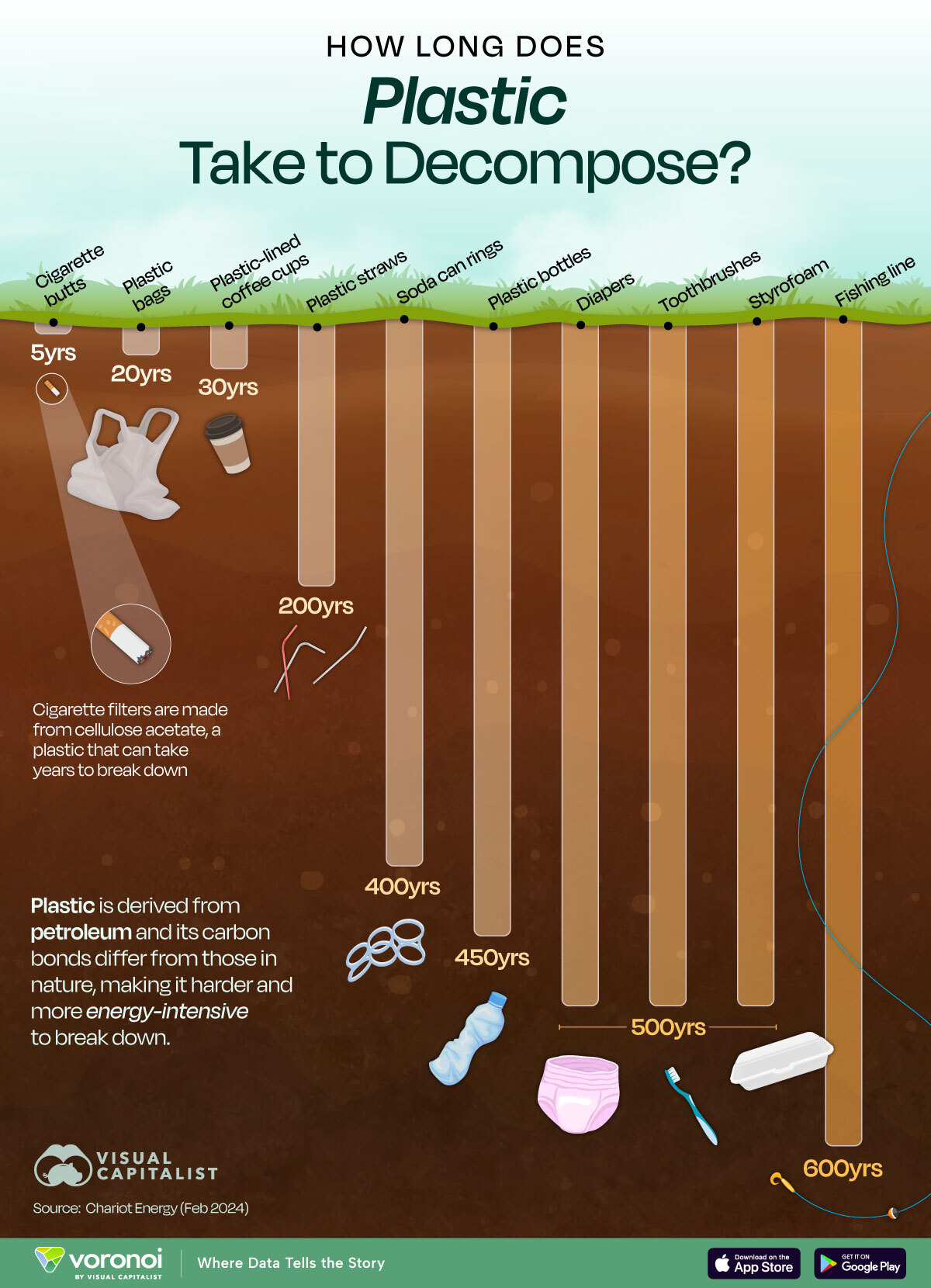
“Plastic Take to Decompose …” from www.visualcapitalist.com and used with no modifications.
The Shocking Truth About Plastic in Landfills
The reality of plastic in landfills is far more disturbing than most people realize. When archaeologists and researchers excavate landfills from the 1960s, they often find intact plastic bags and packaging—sometimes still readable despite being buried for over 60 years. This discovery directly contradicts the already lengthy estimated decomposition times, suggesting that in actual landfill conditions, plastic may never fully decompose.
Currently, over 27 million tons of plastic waste enter landfills in the United States alone each year. This waste doesn't just sit inertly—it slowly leaches chemical additives like phthalates and BPA into surrounding soil and potentially into groundwater.
Moreover, as landfills become increasingly packed with plastic that won't break down, we face a spatial crisis: where will all this waste go when landfills reach capacity?
The modern landfill, designed to minimize environmental contamination, ironically creates conditions that preserve plastic rather than degrade it. Without exposure to UV radiation from sunlight and with limited microbial activity, plastic remains frozen in time, creating a preservation chamber rather than a decomposition environment.

“Take Garbage to Decompose …” from www.helgilibrary.com and used with no modifications.
Different Types of Plastic and Their Decomposition Rates
Not all plastics are created equal when it comes to decomposition. The chemical composition and structure of different plastic types dramatically affect how long they persist in the environment. Understanding these differences can help us make more informed choices about which plastics we use and how we dispose of them.
Plastic Bags: 10-20 Years
Polyethylene plastic bags are among the “faster” decomposing plastic items, taking approximately 10-20 years to break down in optimal conditions. However, in the oxygen-deprived environment of a landfill, this process slows dramatically.
The thin structure of plastic bags allows for more surface area exposure to degrading elements, which explains their relatively shorter decomposition timeline compared to other plastics.
Nevertheless, during their decomposition period, a single plastic bag can harm countless wildlife species if it escapes into the environment.
Plastic Bottles: 450-1000 Years
Polyethylene terephthalate (PET) bottles are among the most persistent plastics in landfills. A standard plastic water bottle requires at least 450 years to decompose, with some estimates extending to 1,000 years.
The thickness and chemical stability of these bottles make them remarkably resistant to natural degradation processes. Consider this sobering thought: the plastic bottle you throw away today might still exist in the year 2474, outlasting countless generations of your descendants.
To understand more about the persistence of plastics, you can explore how long until plastic decomposes in various environments.
Despite being highly recyclable, only about 29% of plastic bottles actually make it to recycling facilities. The rest end up in landfills or as environmental litter, creating a legacy of waste that will far outlast our lifetimes.
When they do eventually begin to break down, they don't biodegrade but instead fragment into microplastics that continue to persist in the environment.
Styrofoam: 500+ Years
Expanded polystyrene, commonly known as Styrofoam, is perhaps the most notorious landfill offender. This lightweight material can persist for more than 500 years in landfill conditions.
What makes Styrofoam particularly problematic is its high volume-to-weight ratio – it takes up significant landfill space while providing minimal utility during its brief useful life.
The material's resistance to compression and chemical breakdown means that Styrofoam products manufactured in the 1970s still exist virtually intact in today's landfills.
Disposable Diapers: 450 Years
Modern disposable diapers contain a complex mixture of plastic polymers, synthetic rubber, and absorbent materials that take approximately 450 years to decompose.
With the average baby using between 5,000-6,000 diapers before potty training, a single child's diaper waste can create nearly 2,000 pounds of material that will persist in landfills for centuries.
The absorbent polymers used in diapers are specifically designed to resist breaking down when wet, ironically making their most useful feature the very reason they persist so long in the environment.
Plastic Straws: 200 Years
The humble plastic straw, used for an average of just 20 minutes, takes approximately 200 years to decompose in landfill conditions. These small items may seem insignificant, but Americans alone use an estimated 500 million plastic straws daily.
Their small size makes them particularly problematic in waste sorting facilities, often allowing them to slip through filtering systems and end up in waterways where they pose significant threats to marine life.
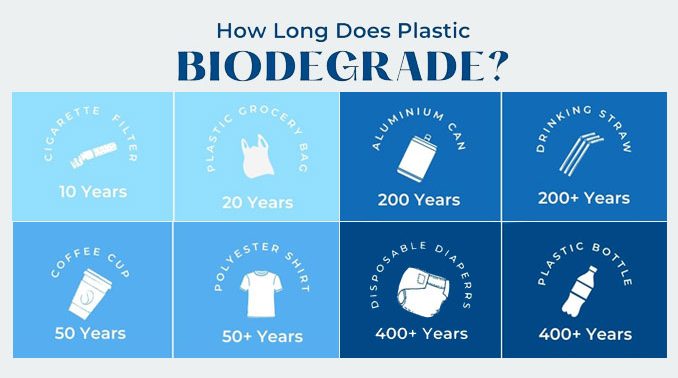
“Plastic to Decompose …” from earthhow.com and used with no modifications.
Why Plastic Takes So Long to Break Down
Understanding the science behind plastic's remarkable durability helps explain why these materials persist for so long in our environment. Plastics weren't designed to break down – quite the opposite. They were engineered specifically for durability, resistance to degradation, and longevity. For more information on how waste is managed, you can explore the ramp method of waste disposal.
The Science Behind Plastic's Durability
At its core, plastic's resistance to decomposition stems from its molecular structure. Most plastics are synthetic polymers – large molecules made of repeating subunits linked by strong carbon-carbon bonds. These bonds are extraordinarily stable and resistant to natural degradation processes.
Unlike organic materials that microorganisms can easily digest, plastic's carbon backbone doesn't provide accessible energy for decomposers. The synthetic nature of these polymers means they don't exist naturally in the environment, so few organisms have evolved mechanisms to break them down efficiently.
Additionally, manufacturers often add stabilizers, plasticizers, and other chemical additives that further enhance durability and resistance to degradation from heat, light, and microbial action.
These additives, while useful for extending the product's shelf life, significantly slow down any potential decomposition process once the plastic reaches a landfill.
Landfill Conditions That Slow Decomposition
Modern landfills are designed to minimize environmental contamination by essentially mummifying waste rather than promoting decomposition. Compacted waste creates anaerobic (oxygen-free) conditions that dramatically slow biodegradation processes for all materials, especially plastics.
Without oxygen, even specialized microorganisms struggle to break down plastic polymers. Furthermore, landfills shield waste from sunlight, eliminating photodegradation – one of the few natural processes that can begin breaking down plastic molecules.
The relatively stable temperature and moisture conditions inside landfills also inhibit the expansion and contraction that might otherwise help mechanically break down plastic items over time.
Even biodegradable plastics, designed to break down more quickly, often fail to decompose properly in landfill conditions.
These materials typically require specific industrial composting conditions including precise temperature, moisture, and microbial activity levels that simply aren't present in standard landfills.
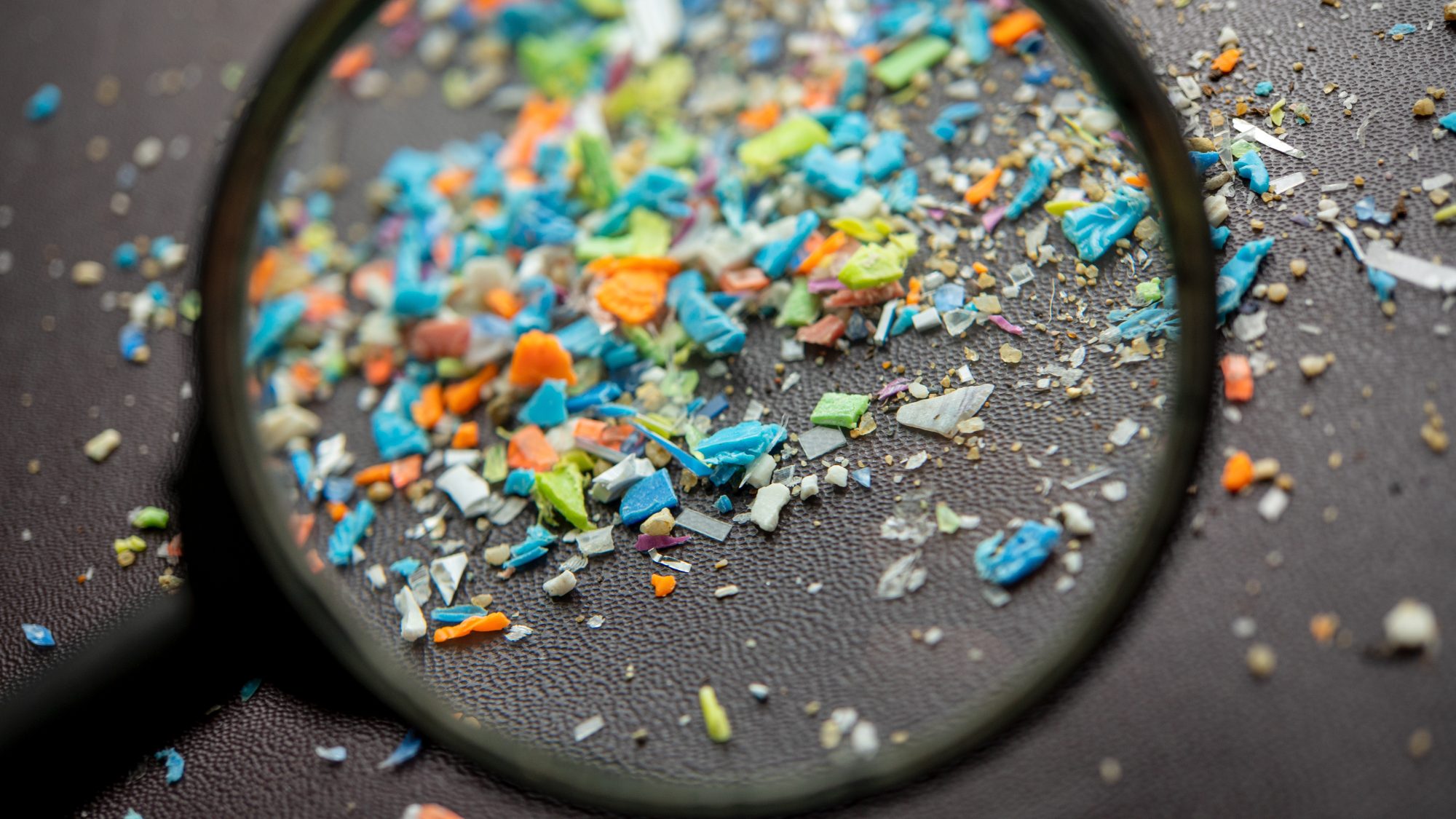
“microplastic pollution” from www.innovationnewsnetwork.com and used with no modifications.
Microplastics: The Never-Ending Legacy
When plastics do begin to break down in landfills, they don't truly biodegrade but rather fragment into increasingly smaller pieces known as microplastics. These tiny particles, measuring less than 5mm in diameter, represent perhaps the most insidious form of plastic pollution.
Microplastics can persist for centuries, slowly leaching chemical additives and attracting other environmental pollutants due to their large surface area-to-volume ratio. Research indicates these particles can eventually migrate from landfills into surrounding soil and potentially into groundwater systems, spreading their impact far beyond the landfill boundaries.
Scientists have now detected microplastics virtually everywhere on Earth – from remote mountain peaks to deep ocean trenches, from human placentas to the bloodstream.
This ubiquity underscores a disturbing reality: even when plastic appears to be “breaking down,” it's merely transforming into a different and potentially more harmful form of pollution that can persist indefinitely in the environment. For more insights on sustainable practices, explore how the circular economy in fashion addresses environmental challenges.
What Actually Happens to Plastic in Landfills
The common narrative that plastic eventually “decomposes” in landfills gives a false impression of what actually occurs. To understand the true fate of plastic waste, we need to examine the scientific evidence about how these materials behave in real-world landfill environments.
The Myth of Biodegradation
The term “biodegradation” implies that materials break down through natural biological processes, eventually returning to the environment as harmless components. This simply doesn't happen with conventional plastics in landfills. Unlike organic waste that can be consumed by microorganisms, most plastics remain chemically intact for centuries.
Landfill excavations have repeatedly discovered plastic items that are decades old yet remain perfectly recognizable and functionally unchanged. Environmentally Conscience research has confirmed that even items labeled as “degradable” often require specific conditions absent in landfills to break down effectively.
How Plastic Just Fragments Instead of Disappearing
Rather than truly decomposing, plastic in landfills undergoes a process of fragmentation. Physical stresses, limited chemical reactions, and very slow photodegradation (when exposed to any light) cause plastic items to crack and break into progressively smaller pieces.
This process creates microplastics and eventually nanoplastics, but importantly, the fundamental polymer molecules remain intact. These tiny fragments may become invisible to the naked eye, creating an illusion of disappearance, but they continue to exist in the environment, potentially causing more harm than larger pieces due to their ability to enter food chains and water systems.
This fragmentation process accelerates when plastic escapes landfills and enters the broader environment, especially marine ecosystems.
In oceans, the combination of sunlight, wave action, and salt water can break plastic down into microparticles much faster than in landfill conditions, though the resulting pollution is equally problematic. For more on waste management, check out the RAMP method of waste disposal.
Evidence From Landfill Excavations
Perhaps the most compelling evidence about plastic's longevity comes from archaeological excavations of landfills. When researchers examine waste layers from different decades, they consistently find plastic items in remarkably preserved condition. In one famous excavation of a 1970s landfill section, researchers discovered fifty-year-old plastic bags with still-readable printing and hot dog packages that looked almost new.
These findings directly contradict even the most conservative decomposition estimates and suggest that under actual landfill conditions, plastic items may remain intact for many centuries longer than laboratory tests predict.
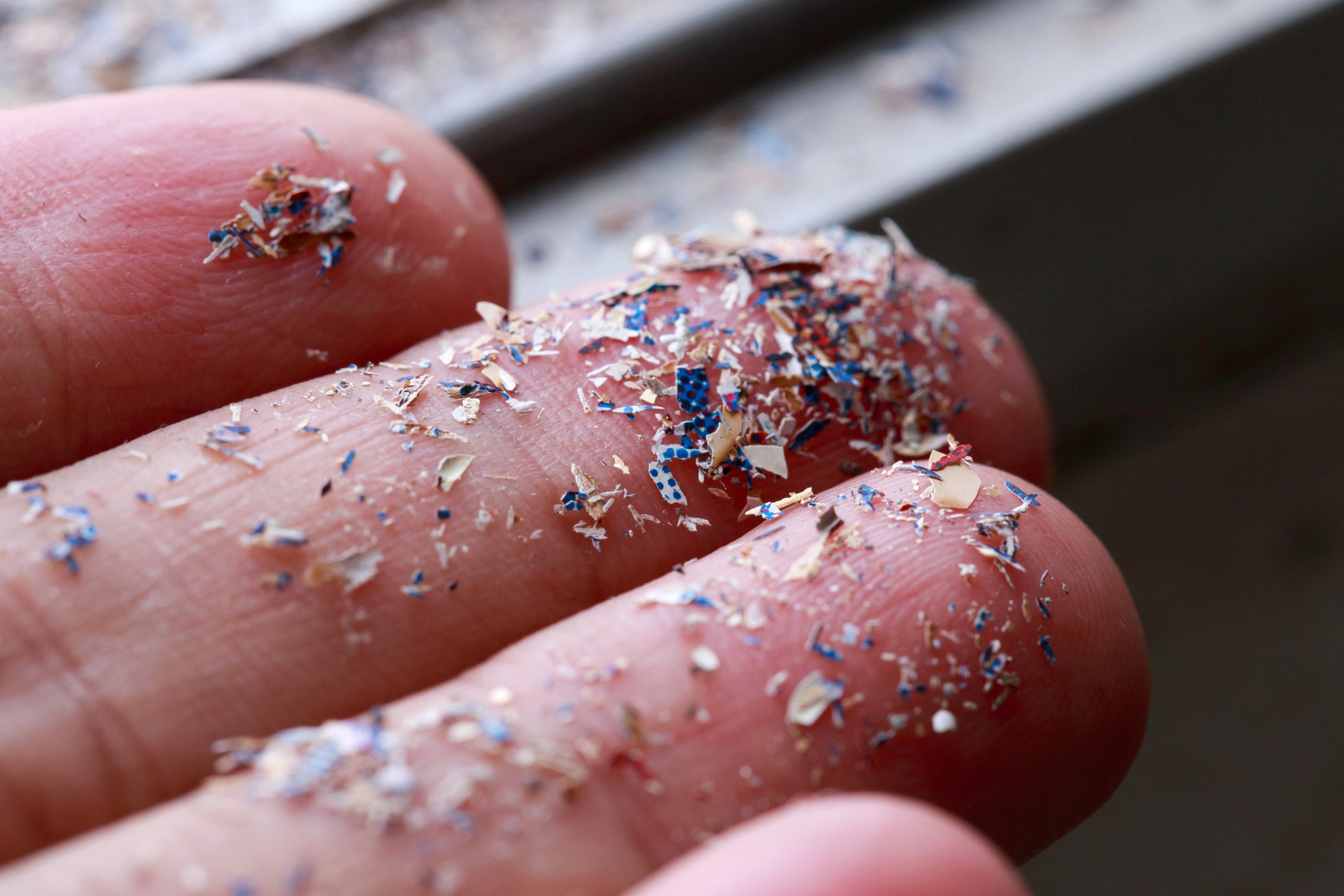
“finds microplastics in bugs …” from www.independent.co.uk and used with no modifications.
“What we found most surprising in our landfill excavation was the pristine condition of plastic packaging from the 1960s. Newspapers had decomposed to the point of being unreadable, but plastic wrappers from the same era could still clearly display brand names and product information.” — Environmental Archaeology Research Team, University of Arizona
Environmental Impact of Slow-Decomposing Plastic
The extraordinarily slow decomposition rate of plastic in landfills creates cascading environmental consequences that extend far beyond simple space concerns. As these materials persist for centuries, they generate impacts that will affect many future generations.
Groundwater Contamination
As plastics in landfills very slowly break down, they can release toxic additives including phthalates, BPA, and flame retardants into landfill leachate—the liquid that forms as waste decomposes and rainwater filters through the landfill.
Modern landfills include liner systems designed to capture this leachate, but no liner remains effective indefinitely. Studies have detected plastic additives in groundwater near landfill sites, indicating that these chemicals can eventually migrate into water systems.
Once in groundwater, these compounds can travel considerable distances, potentially affecting drinking water supplies and aquatic ecosystems far from the original landfill site. Learn more about the benefits and drawbacks of sanitary landfill sites.
Wildlife Hazards
Plastic that escapes from landfills through wind dispersal, water runoff, or wildlife activity creates immediate threats to animals. Birds, marine creatures, and land animals frequently mistake plastic fragments for food, leading to starvation, intestinal blockage, and death.
Microplastics present an even more insidious threat, as they can be inadvertently consumed by filter-feeding organisms and then bioaccumulate up the food chain. Research now shows microplastics present in human food supplies, drinking water, and even human tissue samples, highlighting how widespread this contamination has become.
For more information on the environmental impact of waste, you can read about the benefits and drawbacks of sanitary landfill sites.
Climate Change Connections
The relationship between landfilled plastic and climate change is complex but significant. As plastics slowly degrade in anaerobic landfill conditions, they can release methane—a greenhouse gas approximately 25 times more potent than carbon dioxide at trapping heat in the atmosphere.
Additionally, the production of virgin plastic is extremely energy-intensive and primarily relies on fossil fuel feedstocks. When plastic products end up in landfills rather than being recycled, this creates demand for more virgin plastic production, further driving fossil fuel consumption and associated greenhouse gas emissions.
The persistence of plastic in landfills also represents a form of carbon sequestration, but unlike natural carbon sinks like forests, this storage comes with significant environmental trade-offs and cannot be considered beneficial.
The full climate impact of landfilled plastic includes both direct emissions from degradation and the indirect emissions associated with continued virgin plastic production to replace discarded items.

“microplastic in the ocean …” from www.weforum.org and used with no modifications.
5 Alternatives to Sending Plastic to Landfills
Given the problematic nature of plastic in landfills, finding alternative waste management strategies is essential. Fortunately, several practical options exist that can significantly reduce the volume of plastic entering landfill systems.
1. Recycling: What Actually Gets Recycled
While recycling is often presented as the primary solution to plastic waste, the reality is more nuanced. Not all plastics are created equal when it comes to recyclability.
Currently, only about 9% of plastic waste generated globally is successfully recycled.
The most commonly recycled plastics are PET (#1) bottles and HDPE (#2) containers, which have established recycling markets and processes. Other plastics, particularly mixed or multi-layer materials, are much more challenging to recycle economically.
To maximize recycling effectiveness, focus on properly cleaning and sorting recyclable plastics, and check your local recycling guidelines as they vary significantly between municipalities.
Remember that even recyclable plastics typically can only be recycled a limited number of times before the polymers degrade too much for further processing.
2. Reusable Products Worth Investing In
The most effective way to reduce plastic waste is to prevent it from being created in the first place. Investing in high-quality reusable alternatives to common single-use plastics creates immediate waste reduction and often saves money over time.
Stainless steel water bottles, glass food storage containers, fabric shopping bags, and silicone food preservation wraps all offer durable, non-toxic alternatives to their disposable plastic counterparts.
While the initial investment may be higher, these products typically pay for themselves within months through avoided purchases of disposable items.
- Stainless steel water bottles (replace approximately 167 plastic bottles annually per person)
- Reusable grocery bags (replace 300-500 single-use plastic bags annually per household)
- Beeswax or silicone food wraps (replace up to 100 yards of plastic wrap annually)
- Glass or stainless steel food containers (replace dozens of disposable plastic containers)
- Bamboo or metal straws (replace hundreds of plastic straws annually)
3. Compostable Alternatives
For situations where reusable options aren't practical, truly compostable alternatives can provide a middle ground between conventional plastics and reusables.
Materials like bagasse (sugarcane fiber), mushroom packaging, and PLA (polylactic acid) derived from plant starches offer similar functionality to conventional plastics but can break down completely in proper composting environments.
However, it's important to note that most of these materials require industrial composting facilities with specific temperature and moisture conditions—they won't break down effectively in home composting systems or, crucially, in landfills.
When choosing compostable products, look for certification from organizations like the Biodegradable Products Institute (BPI) and verify that your local waste management system can properly process these materials.
Without appropriate processing, compostable plastics can be just as persistent as conventional plastics in landfill environments.
4. Zero-Waste Shopping Strategies
Zero-waste shopping aims to eliminate packaging waste entirely through thoughtful purchasing habits. This approach includes shopping at bulk food stores with reusable containers, purchasing fresh produce without packaging, and selecting products with minimal or recyclable packaging.
While achieving true zero waste is challenging in our current consumer ecosystem, even modest steps toward this goal can dramatically reduce household plastic waste generation. Many communities now have specialized zero-waste grocery stores or bulk sections in conventional markets that facilitate this shopping approach.
5. Supporting Plastic-Free Businesses
Consumer choices have tremendous power to drive market changes. By intentionally supporting businesses that prioritize sustainable packaging and plastic-free alternatives, consumers can accelerate the transition away from plastic-dependent business models.
Environmentally Conscience partners with companies developing innovative plastic alternatives that decompose naturally without leaving harmful residues. These market-driven solutions often advance more quickly than regulatory approaches and create positive competition that encourages more businesses to adopt sustainable practices.
The Future of Plastic Waste Management
While the current state of plastic in landfills presents significant challenges, emerging technologies and policy approaches offer hope for better management strategies. The coming decades will likely see dramatic changes in how we produce, use, and dispose of plastic materials.
Emerging Decomposition Technologies
Several promising technologies are being developed to address the persistence of plastic waste. Advanced thermal treatment processes like pyrolysis can convert plastic waste into fuel oils and gases without the harmful emissions associated with traditional incineration.
These technologies essentially reverse the polymerization process, breaking plastics back down into their component hydrocarbons. While currently energy-intensive, improvements in process efficiency could make these approaches economically viable alternatives to landfilling.
Chemical recycling technologies that use solvents or catalytic processes to break down plastic polymers are also advancing rapidly. Unlike mechanical recycling, which merely reshapes existing polymers, chemical recycling can return plastics to their basic chemical building blocks, potentially allowing infinite recycling without quality degradation.
These technologies could be particularly valuable for difficult-to-recycle plastic types that currently have few end-of-life options beyond landfilling.
Plastic-Eating Bacteria and Enzymes
One of the most exciting developments in plastic waste management comes from the field of microbiology. In 2016, researchers discovered a bacterium (Ideonella sakaiensis) capable of breaking down PET plastic using specialized enzymes.
Since then, scientists have identified and engineered several other microorganisms and enzymes that can degrade various plastic types. These biological approaches could potentially be deployed in controlled bioreactor systems to process plastic waste or perhaps eventually incorporated into landfill environments to accelerate decomposition.
While still in developmental stages, these biological solutions represent a potentially revolutionary approach to plastic waste. Nature has evolved mechanisms to break down nearly every natural material on Earth, and these emerging biological systems suggest that even synthetic plastics may eventually be integrated into natural decomposition cycles.
Policy Changes on the Horizon
Beyond technological solutions, policy frameworks are evolving to address plastic waste more comprehensively. Extended Producer Responsibility (EPR) regulations, which make manufacturers responsible for the entire lifecycle of their products including disposal, are gaining traction globally.
These policies create economic incentives for companies to design products that are easier to recycle or that use less problematic materials. Additionally, many jurisdictions are implementing bans or taxes on single-use plastics, encouraging both businesses and consumers to adopt reusable alternatives. For more insights, explore the circular economy in fashion as a model for sustainable practices.
Take Action Today: Reducing Your Plastic Footprint
Understanding the persistence of plastic in landfills can feel overwhelming, but individual actions do make a difference. Start by conducting a plastic audit of your household waste to identify your most common plastic disposables, then systematically find alternatives for these items.
Focus first on single-use plastics like water bottles, shopping bags, and food packaging, which typically constitute the largest portion of household plastic waste.
Remember that perfect is the enemy of good—even reducing your plastic consumption by 50% represents significant progress and environmental benefit. Environmentally Conscience provides resources to help consumers make informed choices about reducing plastic waste through our comprehensive guides to sustainable alternatives.
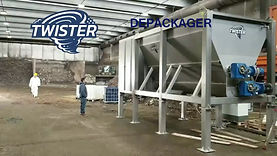
“Twister Food Waste and MSW Depackager …” from www.twisterseparator.com avoids creating microplastic, and used with no modifications.
Frequently Asked Questions
As we've explored the complex issue of plastic decomposition in landfills, several common questions emerge. Understanding these nuances can help consumers make more informed decisions about plastic use and disposal.
Does plastic ever fully decompose in landfills?
In conventional landfill environments, most plastics do not fully decompose in any meaningful timeframe. Instead, they fragment into increasingly smaller pieces while retaining their polymer structure.
The conditions in landfills—limited oxygen, moisture, microbial activity, and sunlight—dramatically slow even the minimal degradation that might occur in more exposed environments. Landfill excavations have found plastic items still intact after 50+ years, suggesting that complete decomposition may take thousands of years, if it occurs at all.
What we often call plastic “decomposition” is actually just fragmentation into microplastics, which themselves persist in the environment indefinitely. These particles may become too small to see, creating an illusion of disappearance, but they continue to exist and potentially cause environmental harm.
Which type of plastic breaks down the fastest?
Among conventional plastics, thin polyethylene films like shopping bags tend to break down relatively faster than thicker, more durable plastics like PET bottles or polystyrene foam.
However, “faster” is relative—these materials still persist for decades at minimum. Some newer bioplastics derived from plant materials like PLA (polylactic acid) or PHA (polyhydroxyalkanoate) can break down more quickly under proper composting conditions, but importantly, they still degrade very slowly in landfill environments.
Are biodegradable plastics better for landfills?
Most “biodegradable” plastics provide little benefit in standard landfill environments. These materials are typically designed to break down in specific industrial composting facilities with carefully controlled temperature, moisture, and microbial conditions.
In the oxygen-deprived, compacted environment of a landfill, even these specially designed materials degrade very slowly.
Some biodegradable plastics may actually create more problems in landfills, as their partial breakdown can release methane, a potent greenhouse gas. For biodegradable plastics to offer genuine environmental benefits, they must be properly sorted and sent to appropriate composting facilities rather than landfills.
How can I tell which plastics are recyclable?
Most plastic products feature a resin identification code (the number inside the triangular recycling symbol) that indicates the type of plastic used.
While theoretically all plastics #1-7 could be recycled, practical recycling infrastructure typically only processes certain types.
In most American communities, #1 (PET) and #2 (HDPE) are most consistently recycled, with limited processing of #5 (polypropylene).
However, recycling programs vary significantly by location, so it's essential to check your local recycling guidelines. Many municipalities provide detailed recycling guides outlining exactly which plastic types and forms they accept.
What happens to plastic that's incinerated instead of landfilled?
Modern waste-to-energy incineration facilities burn plastic at high temperatures, converting the material into energy, carbon dioxide, water vapor, and ash.
This process eliminates the long-term persistence issues associated with landfilling but creates different environmental concerns. Incineration releases greenhouse gases and, if not properly controlled, can emit toxic substances including dioxins, furans, and heavy metals.
Advanced emissions control technologies in modern facilities significantly reduce these harmful outputs, but incineration still represents a less-than-ideal solution to plastic waste. From a sustainability hierarchy perspective, reduction, reuse, and recycling all rank above incineration as preferred management strategies for plastic waste.
By understanding the true nature of plastic decomposition in landfills, we can make more informed choices about our plastic consumption and disposal.
While perfect solutions remain elusive, combining thoughtful consumer choices with emerging technologies and evolving policies offers a path toward more sustainable management of plastic materials.
Environmentally Conscience continues to lead research into sustainable alternatives that break down naturally without leaving harmful residues. Visit our website to learn more about our innovations in biodegradable materials and how you can reduce your plastic footprint.
Unfashionable Talk About Landfills
Get ready for unfashionable talk about landfills! Let's talk rubbish—literally. You might not think about landfills much unless the smell drifts your way on a windy day or you're tossing out the garbage. But these dumping grounds are more than just piles of junk; they're a snapshot of our consumer habits and a challenge we need to tackle. Landfill […]
What is a Landfill?
So, you ask, “What is a Landfill?” Stay and read on here, and we will tell you! A landfill is an engineered pit, or raised hill, in which layers of solid waste are filled, compacted and covered for final disposal. According to UNEP (2002), a basic landfill is a pit with a protected bottom (to […]
Why Every Landfill Liner Leaks But Not All Leakage Matters
Landfill liner leaks are endemic. A small amount escapes from composite landfill lining systems which include both 1 metre thick a clay layer, and a clay liner loses water/ leachate according to its permeability and the head of pressure of leachate over it. That is despite applying stringent design and operational requirements for landfills, landfills continue […]
Landfill Environmental Problems – Emissions
MSW Landfills are very unpopular due to the many environmental problems which have been attributed to landfills. In Europe there is massive investment underway to substantially reduce reliance on landfills. In many areas worldwide landfill space is running out, due to public hostility arising from public perception of landfills and environmental problems, and a crisis […]









